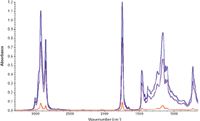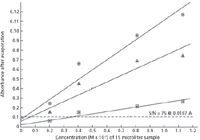Probing the Detection Limits of Concentrated Multiple Reflection ATR Spectroscopy
Probing the Detection Limits of Concentrated Multiple Reflection ATR Spectroscopy
Some simple experiments are conducted to gauge the sensitivity of new multiple reflection ATR equipment and techniques.
Concentrated Multiple Reflection ATR (CMRATR) spectroscopy is a technique, using specialized equipment, which provides the sensitivity of multiple reflection ATR analysis of small amounts of liquids in a confined area hitherto reserved for single reflection ATR. A newly refined evaporative sample technique exploits CMRATR in analyzing the solutes of dilute solutions after evaporation of the solvent. A previous study (1) suggested a high level of sensitivity for CMRATR/evaporation yet made no attempt to quantify the level.
Experimental Conditions
All spectra were acquired using an FTIR spectrometer with the resolution set to 4 cm-1 and the number of scans set to 128. The spectra of virgin olive oil were taken using the Harrick MVP-Pro™ single reflection Si ATR accessory, the ConcentratIR™ multiple reflection Si ATR accessory, and the ConcentratIR™ with a new enhanced sensitivity Si ATR top. This latter configuration was then used to obtain spectra on 15 µL samples of various dilutions of carminic acid in methanol after evaporation of the solvent.
Results and Discussion
Figure 1 shows the absorbance spectra obtained for olive oil using the three equipment configurations. When the absorbance values obtained by CMRATR and enhanced CMRATR are compared with single reflection ATR, they are 12 ± 2 and 17 ± 3 times as intense, respectively, and signal-to-noise levels increase by factors of 14 and 60.

Figure 1: Spectra of virgin olive oil by single reflection ATR (bottom), CMRATR (middle), and enhanced CMRATR (top).
Figure 2 plots the absorbance levels (after evaporation) vs. the concentration (prior to evaporation) of the 15 µL carminic acid samples, using three peaks of low, medium, and high relative intensity. Noise and linear regression analyses indicate that, with an S/N of 75, material amounts down to 0.2 µg can be determined.

Figure 2: Absorbance vs. concentration for carminic acid peaks at 768 cm-1 (bottom), 1081 cm-1 (middle), and 1568 cm-1 (top).
Conclusions
CMRATR has been shown to be an extremely sensitive technique, allowing 12 to 17 times the sensitivity of conventional single reflection ATR with S/N levels as high as 4000. In fact, the enhanced version may, for some applications, yield absorbance values that are too high. A review of individual peak data indicates a general trend: sensitivity increases are greater for less intense peaks. This extends the usefulness of CMRATR in the analysis of weak peaks that would otherwise be lost in noise, especially in cases where only small amounts of sample are available.
The evaporative technique described here is a force multiplier when combined with CMRATR. Solvent interference is removed and the solute to be analyzed is left automatically in intimate contact with the ATR sampling surface. As such, the CMRATR/evaporation technique may be complementary to the HPLC methodology described by Koren (2) for the analysis of dyes extracted from archaeological artifacts.
Future work in our laboratories will include efforts to lower the detection limits of CMRATR/evaporation. Strategies that will be investigated include decreasing the resolution, increasing the number of scans, and obtaining better uniformity of the evaporated sample deposition.
References
(1) J.P. Lucania and A. Kocak, 2012 Pittsburgh Conference, Paper No. 220-4P.
(2) Z.C. Koren, Dyes in History and Archaeology 21, 26–35 (2008).
Harrick Scientific Products, Inc.
141 Tompkins Ave., Box 277, Pleasantville, NY 10570
tel. (914) 747-7202, fax (914) 747-7409
Email: info@harricksci.com, Website: www.harricksci.com

Thermo Fisher Scientists Highlight the Latest Advances in Process Monitoring with Raman Spectroscopy
April 1st 2025In this exclusive Spectroscopy interview, John Richmond and Tom Dearing of Thermo Fisher Scientific discuss the company’s Raman technology and the latest trends for process monitoring across various applications.
A Seamless Trace Elemental Analysis Prescription for Quality Pharmaceuticals
March 31st 2025Quality assurance and quality control (QA/QC) are essential in pharmaceutical manufacturing to ensure compliance with standards like United States Pharmacopoeia <232> and ICH Q3D, as well as FDA regulations. Reliable and user-friendly testing solutions help QA/QC labs deliver precise trace elemental analyses while meeting throughput demands and data security requirements.